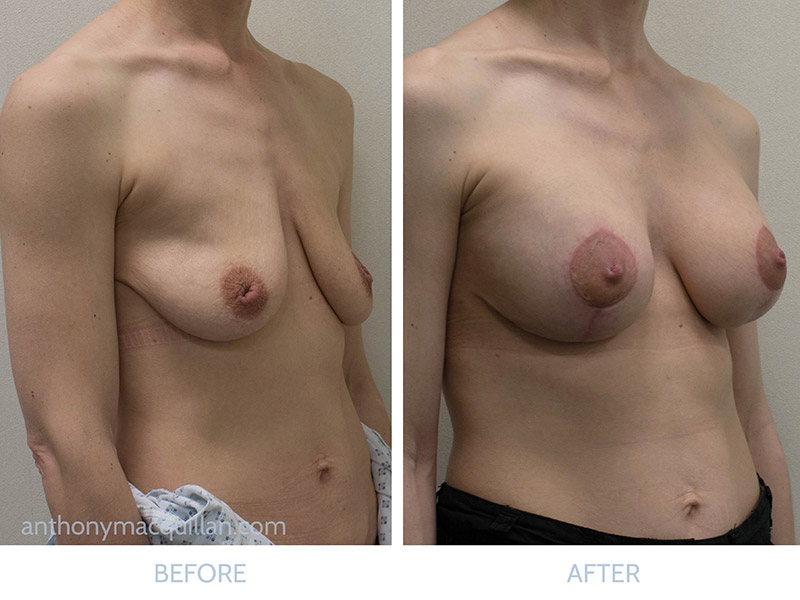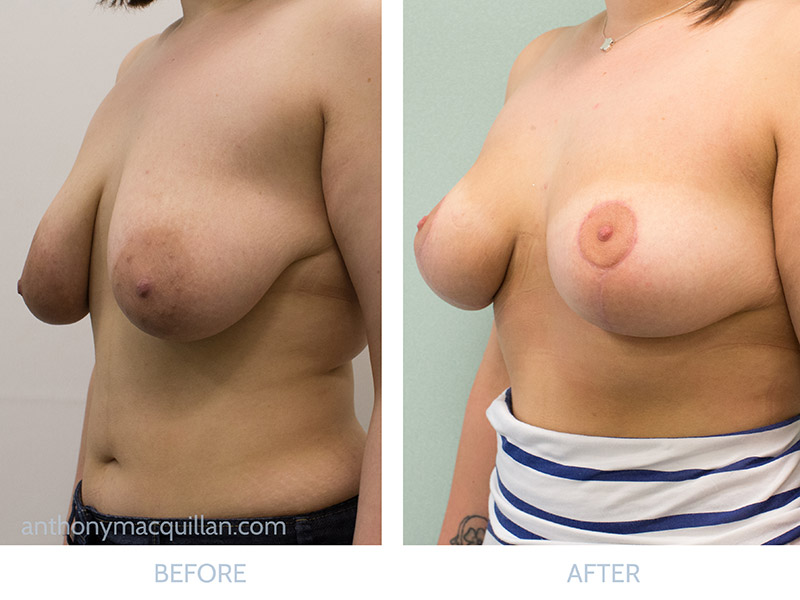How to Safely Resume Exercise after Breast Uplift Surgery
Starting to exercise again after Breast Uplift surgery is a big step. It’s about more than just getting back into shape or hitting fitness goals. This phase is really about getting to know your body all over again, figuring out what feels good, and taking things one day at a time.
After surgery, your body needs time to heal, and jumping back into exercise isn’t just a physical challenge; it’s a mental one too. It’s about learning to be patient with yourself, understanding your limits, and gradually building your strength back up.
Consultant Plastic Surgeon Anthony MacQuillan aims to offer tips and advice on how to safely get moving again, without rushing or pushing too hard.

Your Body after Breast Uplift Surgery
When you’ve just had Breast Uplift surgery, it feels like you’re starting a new chapter with your body. It’s like getting to know an old friend again, but they’ve changed a bit, and so have you. This journey is about more than just the physical healing; it’s about adjusting to those changes, both on the outside and the inside. Here is what you should keep in mind:
Physical Expectations After Breast Uplift Surgery
Right after surgery, your body is going to feel different, and it’s going to show. Swelling, bruising and feeling sore are all par for the course. It’s like after a really strenuous workout, but a bit more intense. Your chest area will be tender, and you’ll need to take it easy to let your body do its thing and heal.
Anthony will tell you to wear a special bra that supports your chest while you’re healing. It might not be the most fashionable item in your wardrobe, but it’s going to be a big help in your recovery.
Emotional Adjustments
This part is a bit of a rollercoaster. One day you might be over the moon, excited about the changes, and the next day, you might feel a bit down or anxious about the recovery process. That’s all normal. Your body has been through a lot, and your mind needs time to catch up.
The Recovery Timeline
Everyone’s body heals at its own pace, so don’t compare your recovery to someone else’s. Generally, you’ll start to feel more like yourself a few weeks after surgery, but it can take a few months before you’re fully healed and can see the final results. It’s a bit like waiting for a cake to bake. You can’t rush it, and you have to trust that it’ll turn out okay in the end.
During this time, you’ll have check-ups with Anthony to make sure everything is healing as it should.
Signals to Watch For during Recovery after Breast Uplift Surgery
While you’re healing, your body will send you signals. Some are good signs, like when the swelling starts to go down. Others are like warning lights on your car’s dashboard, telling you something needs attention. If you have severe pain, unusual swelling, or anything else that feels off, it’s time to call Anthony. It’s better to be safe and get things checked out than to ignore something that could be important.
Expectations after Breast Uplift Surgery
In today’s world of instant everything, it’s easy to expect quick results. But when it comes to healing from surgery, your body doesn’t care about instant gratification. It’s going to take time to heal, and that’s perfectly okay.
Setting realistic expectations means understanding that recovery is a process. Some days you’ll feel great, and other days not so much. Celebrate the small victories, like the first time you can get dressed without help or the day you can finally ditch that special bra for something a bit more you.
It’s also about understanding that your body might look and feel different than you expected, and that’s okay too. The goal here isn’t perfection; it’s about feeling good in your skin. Getting through Breast Uplift surgery recovery is a journey, with its ups and downs.

Reintroducing Exercise after Breast Uplift Surgery
Getting ready to exercise again after your surgery is a bit like gearing up to jump back into the dating scene after a long break. It’s exciting but also a bit nerve-wracking. You know it’s going to be good for you, but there’s that little voice in your head asking if you’re really ready. The trick is to start by getting your mind in the game. Remind yourself why you’re doing this – for your health, strength, and happiness. Give yourself a pep talk, set some gentle goals, and remember, this is about feeling good and finding what works for you now.
- Phased Reintroduction to Physical Activity: Jumping straight into your old workout routine after surgery is not a great idea. In the early days of getting back into exercise, think of your workouts as a gentle reintroduction, focus on simple, low-impact movements that get your body moving without putting too much strain on it. Walking, stretching, and light yoga are your best friends here. These activities help keep your muscles active and your joints limber, all without overdoing it.
- Gradual Increase in Activity: As you start feeling more comfortable and confident in your movements, it’s time to slowly turn up the dial. But remember, avoid going from zero to hero overnight, add a little more intensity to your workouts, try some resistance training with light weights, or increase your walking pace.
- Incorporating Mind and Soul Exercises: Incorporate activities that make you feel good on the inside, like meditation, yoga, or tai chi. These practices help connect your body and mind, offering a sense of peace and balance that can be incredibly healing. They remind you to breathe, be present, and appreciate your body for all it’s been through and all it can do.
Long-term Exercise Strategies
After getting through the initial stages of reintroducing exercise after Breast Uplift surgery, the focus shifts towards sustaining progress and establishing a long-term exercise routine. This phase is about more than just maintaining physical activity; it’s about integrating exercise into your lifestyle in a way that supports your surgical recovery, overall health, and personal fitness goals.
Creating a Sustainable Plan for Exercise after Breast Uplift
Start by figuring out what kind of exercises you actually like. There’s no point in forcing yourself to run if you hate it. Maybe you’re more of a dance class or hiking person. Then, look at your week and see where you can realistically fit in some activity. It doesn’t have to be a marathon session every time; even short, 15-minute walks count. The goal here is to make exercise a regular part of your life, not something you dread or have to force. Think of it as a habit, like brushing your teeth, but a bit more fun.
Incorporating Variety into Your Workouts
Doing the same workout every day can get as boring as eating the same breakfast every morning. Spice things up by mixing different types of exercises into your routine. Try a bit of everything — strength training, cardio, yoga, swimming — to keep things interesting and work different muscle groups. It’s also a great way to discover new activities you might enjoy. Plus, mixing it up helps prevent overuse injuries and keeps your body guessing, which can be good for your fitness levels.
Setting Achievable Goals
Start with small, realistic goals, like doing a 10-minute workout three times a week, and gradually build from there. Celebrate when you reach these milestones, then set new ones. The aim here is progress, not perfection. By setting achievable goals, you’re more likely to stick with your plan and not get discouraged.
Staying Motivated Long Term
Keeping the exercise flame alive over time can be challenging. To stay motivated, keep reminding yourself why you started in the first place. Maybe it’s for your health, to feel stronger, or just to have some ‘me’ time. Find a workout buddy or join a group class to add a social element to your workouts, making them more fun and giving you a reason to show up. Tracking your progress can also be a big motivator. Seeing how far you’ve come can give you that push to keep going.
FAQs about Exercise after Breast Uplift Surgery
When can I start exercising again after my Breast Uplift Surgery?
- You can start introducing light activities, like walking, about a week or two after surgery, but only if you feel up to it and with Anthony’s OK. Remember, every person’s recovery is different, so it’s important to follow your own surgeon’s advice. For more strenuous exercises, especially those that involve the upper body, you might need to wait 6 to 8 weeks, or until your surgeon gives you the green light.
What types of exercises are safe to do first after my surgery?
- Start with low-impact activities that don’t put too much strain on your chest. Walking is a great option to get you moving without overdoing it. You can also do gentle lower-body exercises like leg lifts and stationary cycling without resistance. Avoid anything that involves bouncing or high impact until Anthony advises it’s safe to proceed.
How will I know if I’m pushing myself too hard when I get back to exercising?
- Listen to your body — it’s your best guide. If you experience any new or worsening pain, especially in the area of your surgery, that’s a sign to ease up. Other red flags include increased swelling, any bleeding from the incision sites, or any signs of infection like fever or unusual discharge. If you notice any of these symptoms, contact your surgeon right away.
Are there any exercises I should avoid after Breast Uplift Surgery?
- Yes, in the initial weeks following your surgery, you should avoid exercises that put direct pressure on your chest or involve heavy lifting. This includes push-ups, chest presses, and heavy weightlifting. Anthony can provide a detailed list of activities to avoid and will let you know when it’s safe to gradually reintroduce them into your routine.
How can I ensure I don’t harm my surgical results while exercising?
- The key is to start slow and follow Anthony’s recommendations closely. Wear a supportive sports bra that’s designed for post-surgical recovery when you exercise to protect your breasts and provide adequate support. Pay attention to your body’s signals and don’t rush into high-impact activities too soon. Gradually increasing the intensity of your workouts allows your body to adapt without risking your results.
Further Reading about Surgery with Consultant Plastic Surgeon AnthonyMacQuillan
- Stitches after Blepharoplasty
- How to Reduce Bruising and Swelling after Facelift
- Recovery after Neck Lift Surgery
- Recovery after Facelift
- Procedures to Have with a Facelift
Medical References about Breast Lift Surgery
- Breast Lift (Mastopexy): Surgery & Recovery – Cleveland Clinic
- Breast Lift Guide – American Board of Cosmetic Surgery
- Breast Lift | Cosmetic Surgery – Stanford Medicine
- Breast Lift – American Society of Plastic Surgeons
- Breast Lift – Australian Society of Plastic Surgeons



